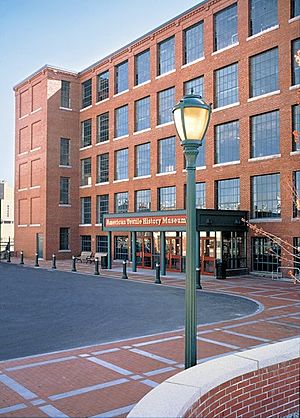American Textile History Museum facts for kids
 |
|
| Established | January 1960 |
|---|---|
| Dissolved | June 14, 2016 |
| Location | Lowell, Massachusetts |
| Public transit access | MBTA Lowell |
The American Textile History Museum (ATHM) was a special place in Lowell, Massachusetts. It told the story of America through the amazing world of textiles. Textiles are fabrics and materials we use every day. The museum showed how these materials were made and how they changed over time. It closed its doors in June 2016. Many of its important books, records, and fabric samples are now kept at Cornell University.
Contents
The Museum's Journey: From Idea to Reality
How the Museum Started
The museum began with a woman named Caroline Stevens Rogers. In 1958, she inherited a large collection of old tools for making cloth. These included over 50 spinning wheels and parts of old hand looms. Her father, Samuel Dale Stevens, had collected these items over 50 years. Caroline's husband, Horatio Rogers, helped restore many of them.
Caroline wanted to share her father's collection. As president of the North Andover Historical Society, she decided to add the collection there. In 1959, J. Bruce Sinclair, the first Director of the Historical Society, suggested creating a regional textile museum. He imagined a museum focused on wool and its history in the Merrimack Valley.
Growing and Changing Names
In January 1960, a group met and agreed the museum should cover more than just one area or time. It would focus on the important story of textiles. Plans for a new building began in May 1960 and finished by summer 1961. This new space had areas for exhibits, study collections, and offices. The museum's staff also grew, adding a curator and a librarian.
The first exhibits showed how wool was made. They explained the journey from sheep-shearing to dyeing cloth. The displays used models, pictures, and real tools. They showed how cloth production changed from hand-made to machine-made. Some machines on display included a wool picker and a large spinning jack.
In 1971, the museum became officially recognized by the American Alliance of Museums. By 1973, its focus had grown to include textile history across much of the United States up to 1950. The museum also expanded its buildings. A library wing was added in 1967, and a large building called Machinery Hall was completed in 1971. This hall stored many tools and machines.
In 1984, the museum's leaders decided to change its name. They wanted a name that showed its wider focus. So, on September 1, 1984, it became the Museum of American Textile History (MATH). At this time, the museum also started to study man-made and modern materials. It became clear that the North Andover location was too small for the growing collection.
Moving to Lowell
The museum needed a bigger home with better public access. They first considered moving to Lawrence, but it was too expensive. The search continued, and in April 1992, the museum bought an old factory building in Lowell. This building, called the Kitson Shop, was built in the 1860s and used to make textile machinery. Moving to Lowell meant the museum would be in the heart of a historic textile manufacturing city.
MATH moved to Lowell on April 27, 1997. In Lowell, it became the American Textile History Museum (ATHM). The museum closed in 2007 for renovations to its exhibit spaces. This led to a big effort that raised over $4 million. In 2008, ATHM introduced its mascot, Lulu the Lamb. The museum reopened in June 2009 with new, interactive exhibits for all ages. It also became a member of the Smithsonian Affiliations, allowing it to work with Smithsonian Institution museums.
Jonathan Stevens became the President and CEO in November 2011. He had a strong background in the textile industry.
The Museum's Closure
Sadly, due to financial problems, the museum announced its permanent closure in June 2016. After it closed, its collections were shared among many colleges and museums. For example, craft tools went to the Mansfield School of Weaving. The Kheel Center at Cornell University received most of the library and archives. The American Textile Hall of Fame exhibit is now at Revolution Cotton Mills in Greensboro, North Carolina. As of 2025, a textile mill in Franklinville, North Carolina, was being prepared to display the ATHM's machinery.
Osborne Library
The Osborne Library was an important part of the ATHM. It held a huge collection of books, pictures, and old documents about textiles. Many different people used the library, including designers, architects, and people who loved to spin and weave.
Exciting Exhibits
Textile Revolution: An Exploration through Space and Time
The main exhibit at the ATHM was called "Textile Revolution: An Exploration through Space and Time." It showed how textiles are changing our world. You could see examples of materials used in many ways. These included protective clothing for firefighters and soldiers. It also featured special "shark skin" swimsuits worn by Olympic swimmers.
American Textile Hall of Fame
The ATHM also had the American Textile Hall of Fame, which ran from 2001 to 2014. This hall honored people, companies, and groups who made big contributions to the textile industry. It also celebrated those who helped people appreciate textiles in America.
Some people and groups honored included:
- Roger Milliken (2001)
- Samuel Slater (2001)
- DuPont (2002)
- Levi Strauss & Co. (2008)
- Pendleton Woolen Mills (2008)
- W. L. Gore and Associates (2009)
- Stephanie Kwolek (2011)

